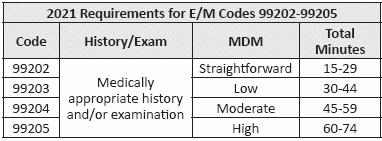Be Ready to Change Your New Patient Outpatient E/M Coding
On Jan. 1, 2021, 99201 will be no more. CPT® code 99201 (Office or other outpatient visit for the evaluation and management of a new patient …) isn’t one of the most-used E/M codes. Which is why the news that the code is being deleted from the CPT® code set come the beginning of next year probably won’t come as a big shock. Nevertheless, the American Medical Association’s (AMA’s) decision to axe 99201 is important for you to understand, as it sets the stage for the big shakeup in office and outpatient E/M coding that is just around the corner. Because the deletion highlights the even bigger decision to make medical decision making (MDM) and time the only two factors you will use to calculate office and outpatient E/M codes beginning in 2021. So, here’s a closer look at some of the big changes that are just around the corner. Here’s Why You’ll Say Goodbye to 99201 If you look at the code descriptor for 99201 (Office or other outpatient visit for the evaluation and management of a new patient, which requires these 3 key components: A problem focused history; A problem focused examination; Straightforward medical decision making …), you’ll see that it requires “straightforward MDM.” Now review the code descriptor for 99202 (Office or other outpatient visit for the evaluation and management of a new patient, which requires these 3 key components: An expanded problem focused history; An expanded problem focused examination; Straightforward medical decision making…). This also requires “straightforward MDM.” With the new emphasis on MDM, these two codes are redundant when selecting the code based on MDM. Check Out Changes to 99202-99205 So, the new codes, as of January 1, 2021, won’t require the three components and won’t reference typical face-to-face time. Here’s what they will include. You’ll see the code descriptors describing “a medically appropriate history and/or examination.” Then, your code selection will be based on the MDM level or the total time the oncologist spent with the patient on that date of service. For instance, here is the difference in code descriptors for 99203: All of the outpatient codes for new patients (99202-99205) follow this structure. Notice how this descriptor specifies both a level of MDM and time. The other codes do as well. Here’s a breakdown of these requirements in a table form: Keep in mind: If this new outpatient visit lasts more than 74 minutes, you’ll report a prolonged services add-on code that is temporarily referred to as +99XXX. Warning: “You can report 99205 with the prolonged services code when 75 minutes is reached,” says Raemarie Jimenez, CPC, CIC, CPB, CPMA, CPPM, CPC-I, CCS, senior vice president of product at AAPC and coding liaison to the AMA CPT® Editorial Panel. Example: Suppose an ob-gyn meets a new post-menopausal patient in the office who is presenting with vaginal bleeding for more than two months, and the visit consists of moderate medical decision making and lasts 45 minutes. If that’s the case, you’ll report 99204. “You do not need both MDM and time,” Jimenez says. In other words, you could look at either the time in this example (45 minutes) or the level of MDM (moderate level), and this will direct you to 99204. Editor’s Note: Have more questions about how new E/M codes will change in 2021? Email the E/M Coding Alert editor at bpegg@codinginstitute.com.


